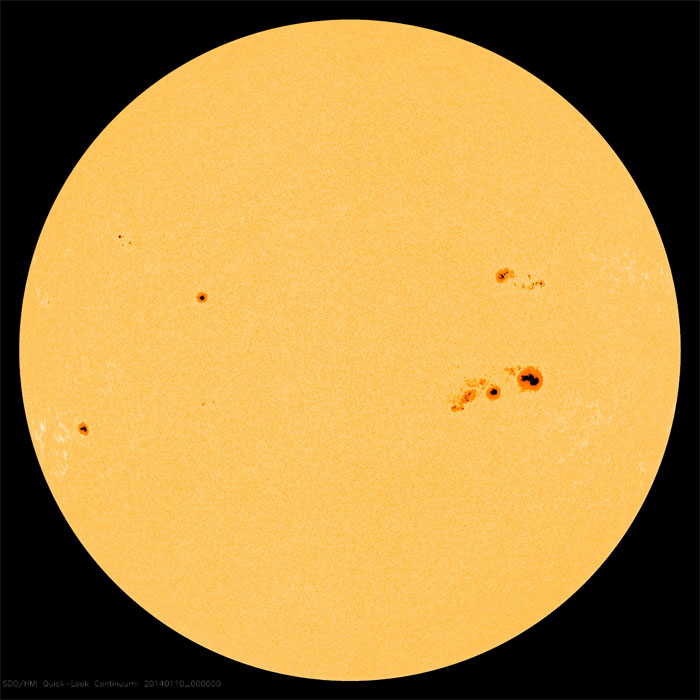.

Sunspot AR1944 has a 'beta-gamma-delta' magnetic field that harbors energy for X-class solar flares. Credit: SDO/HMI
.
NJIT's Center for Solar-Terrestrial Research Monitors
A massive solar storm erupting from a giant, tumultuous sunspot is providing what physicist Andrew Gerrard calls a “beautiful opportunity” to observe and analyze a rare and powerful burst of solar radiation and particles traveling at unusually high speed toward Earth.
The first powerful “X-class” solar flare of 2014, in association with another solar phenomenon, a giant cloud of particles known as a coronal mass ejection (CME), exploded from the sun on Tuesday and has already disrupted operations on the ground. NASA reported on Wednesday that a commercial spaceflight company on a cargo delivery mission to the International Space Station had called off its rocket launch that day from the agency’s Wallops Flight Facility in Virginia because of the high levels of radiation.
“This was a huge event, with the CME now classified as an R-type for its rarity, with an estimated speed much higher than we have recently seen because of the massive release of energy,” commented Gerrard, deputy director of NJIT’s Center for Solar-Terrestrial Research (CSTR). “Eruptions of this magnitude can cause circulation changes in the upper atmosphere, communications disruptions in space and on the ground, including in high frequency radio, and other potential electrical anomalies. We can lose track of space craft, whose orbits can be disrupted by these events. It’s like driving through molasses.”
NJIT is continuing to measure the solar explosion’s impact from space with its instruments on the Van Allen Probes, NASA twin space craft that travel through the inner magnetosphere, and on the ground through instruments like those in the NATION Fabry-Perot systems in North America, which measure thermospheric winds and temperatures, and in systems across the Antarctic plateau that measure geomagnetic variability.
“This is a beautiful opportunity to look at how this material from the sun is injected into the radiation belts, inner magnetosphere, and upper atmosphere. We may not see anything like this for another decade,” said Gerrard, who has been fielding e-mails from his students since the beginning of the storm, which he described as both awe-inspiring and mysterious, even for seasoned physicists.
“What unleashes these massive eruptions of energy and why we can’t reproduce them in a controlled way on Earth are some of the fundamental unsolved questions for physicists that my students are now also beginning to think about,” he noted. “Further, we are even more baffled about how the Earth and its upper atmosphere respond to such energy.”
Gerrard’s graduate, undergraduate, and high-school students, as well as students throughout the Center, will all be studying data collected by the assorted instruments in the coming months, including on wind, temperature, magnetic field, and the density of protons and helium and oxygen ions.
The current flare, a giant burst of radiation designated as X-class for the most intense category, is centered over a giant sunspot AR1944 located at the center of the sun and directed toward Earth. By Wednesday, the solar radiation storm had intensified to an S3 or strong event, while the coronal mass ejection was forecast to set off G3 (Strong) Geomagnetic Storm activity through January 9 and 10, NASA said.
Solar flares and coronal mass ejections regularly send bursts of charged particles and high energy radiation in Earth’s direction at nearly the speed of light. Upon reaching our atmosphere within minutes, solar radiation can destroy the electronic systems in satellites used in telecommunications, weather forecasting and GPS systems, among other services, as well as devices on the ground, such as transformers. In 1989, for example, a solar storm brought down the Hydro-Quebec grid within minutes, blacking out the entire province as well as parts of the Northern United States for several hours.
NJIT’s Center for Solar-Terrestrial Research also operates the university’s Big Bear Solar Observatory (BBSO) in California, which is home to the world’s most powerful ground-based telescope dedicated to solar research. NJIT professors at BBSO in Big Bear have obtained new and remarkably detailed photos of the Sun with the New Solar Telescope (NST). CSTR also runs the Owen’s Valley Solar Array (OVSA) in California, a frequency agile solar radio telescope that explores the solar atmosphere and flare characteristics.
Quelle: NJIT
.
CME IMPACT: As predicted, a CME hit Earth's magnetic field on Jan. 9th (20:00 UT). The impact was weaker than expected, however, and it failed to produce widespread geomagnetic storms. Nevertheless, some beautiful auroras appeared around the Arctic Circle. Harald Albrigtsen sends this picture from Tromsø, Norway:
.

It was dark in Norway when the CME arrived, so observers there witnessed a nice display. By the time night fell over North America, however, the lights had faded. US observers saw nothing remarkable.
More auroras are possible on Jan. 10th as Earth passes through the magnetic wake of the CME. NOAA forecasters estimate a 85% chance of polar geomagnetic storms before the day is over.
Quelle: Spaceweather
5193 Views
